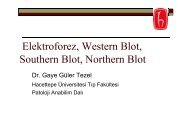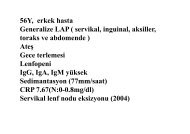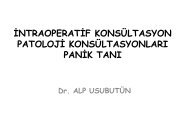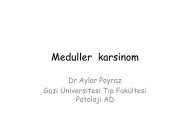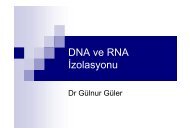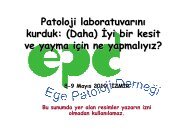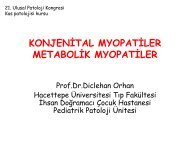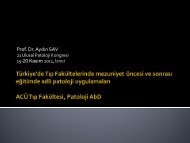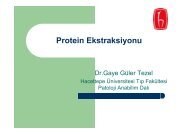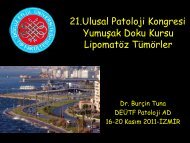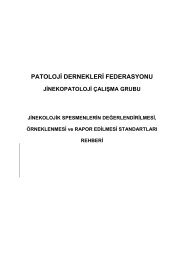Adenosis
Adenosis
Adenosis
You also want an ePaper? Increase the reach of your titles
YUMPU automatically turns print PDFs into web optimized ePapers that Google loves.
Mimickers of Prostate Cancer From<strong>Adenosis</strong> to Xanthoma
Benign Mimickers of Well-ModeratelyDifferentiated Carcinoma• <strong>Adenosis</strong>• Atrophy• Basal cell hyperplasia• Nephrogenic adenoma• HGPIN• Radiation atypia
<strong>Adenosis</strong>(Atypical Adenomatous Hyperplasia)
Incidence• TURP - 1.6%• Needle - 0.8%• Multifocal
Diagnostic Criteria of <strong>Adenosis</strong>Lobular<strong>Adenosis</strong>CancerHaphazard growth patternSmall glands share cytoplasmic andnuclear features with admixed largerbenign glandsPale-clear cytoplasmMedium sized nucleoliBlue mucinous secretions rareCorpora amylacea commonBasal cells presentSmall glands differ in either nuclear orcytoplasmic features from adjacentbenign glandsOccasionally amphophilic cytoplasmOccasionally large nucleoliBlue mucinous secretions commonCorpora amylacea rareBasal cells absent
Features Shared in <strong>Adenosis</strong> and Cancer• Crowded glands• Crystalloids• Medium sized nucleoli• Scattered poorly formed glands and single cells• Minimal infiltration at periphery
Relation of <strong>Adenosis</strong> to Cancer• No difference in risk of subsequent diagnosis ofcancer following TURP diagnosis as compared toBPH• “<strong>Adenosis</strong> is a mimicker of prostate cancer which isnot associated with an increased risk of cancer”
Atrophy
• Post-atrophic hyperplasia• Partial atrophy• Simple atrophy
• Proliferative atrophy linked to prostate carcinogenesis• Atrophy & inflammation associated with increasedproliferation.• Gives rise to reactive oxygen and nitrogen species which inthe setting of increased turnover results in mutations.• If atrophy is associated with cancer, it is not a proximatecause.
• Proliferative atrophy seen in 47% of sextant biopsies• Not associated with cancer on repeat biopsy• Not typically even mentioned in pathology report unlessflorid as a mimicker of cancer.
Partial Atrophy
Basal Cell Hyperplasia
Basal Cell Hyperplasia in thePeripheral Zone of the Prostate• BCH in peripheral zone – 23% of whole prostates• BCH on needle biopsy – 10.2%
Nephrogenic Adenoma(Nephrogenic Metaplasia)
Nephrogenic Adenoma of the Prostatic Urethra:A Mimicker of Prostate Adenocarcinoma• Features mimicking prostate cancer:– Presence of tubules, cords, and signet ring-like tubules– Prominent nucleoli– Muscle involvement– Blue-tinged mucinous secretions (32%)– Focal PSA (36%) and PSAP (50%)– Negative staining for HMWCK in some cases
Nephrogenic Adenoma vs. Prostate Ca.• Focal PSA and PSAP positivity in 1/3 of cases– Tends to not be diffusely strong• Negative staining for HMWCK in 62%-75% of cases• Cases with positive HMWCK rules out prostatecancer• Positive AMACR (racemase) in 35%-58% of cases• Positive PAX2 in NA and not in prostate cancer
PSA
AMACR
HGPIN
PINATYPHigh grade PIN with small focus of atypical glands. Seenote:Note: Adjacent to glands of high grade PIN are a fewsmall atypical glands. While these small glands mayrepresent a small focus of infiltrating cancer, we cannot exclude that they represent outpouching ortangential sections off of the adjacent high grade PIN.
Radiation Change
Radiation Change in the Prostate• RT affect in Benign Prostate - Differential Diagnosisfrom Prostate Cancer• RT results – Affect on Prognosis– Positive for cancer (w/o treatment affect)– Negative for cancer– Positive for cancer (with treatment affect)
• More atypia in cases treated with IRT (seeds) thanXRT• No change in epithelial atypia over time in mentreated with IRT. With XRT, less epithelial atypia incases biopsies >48 months after treatment• RT atypia may persist for a long time: Prominent RTatypia detected 72 months after IRT• Some cases clinicians not aware of remote h/o of RTor do not relay this on to pathologists. Pathologistsmust be able to recognize RT atypia w/o relying onthe clinician to provide this history
Radiation Biopsy Results: Cancer withTreatment AffectHistologically cancer is seen, yet shows treatment effectwith degenerative features. Cancer is present, yet is itviable?Prognosis: Similar to cases with no cancer.Do not grade radiated cancer with treatment effect.
Radiation Biopsy Results: Cancerwithout Treatment AffectHistologically, ordinary prostate cancer is seen, whichresembles non-radiated cancer. Can assign a Gleasongrade.If biopsy performed too soon (12 months following radiation,indicates persistence/progression/recurrence ofcancer.
Benign Mimickers of Moderately-PoorlyDifferentiated Adenocarcinoma• Nonspecific granulomatous prostatitis• Paraganglia• Urothelial carcinoma• Xanthoma
Nonspecific Granulomatous Prostatitis
Paraganglia of Prostate
High Grade Prostatic Adenocarcinomavs.Poorly Differentiated Urothelial Carcinoma
Direct Invasion of UC Into the Prostate(pT4): Invasive UC versus High GradeProstatic AdenocarcinomaPROSTATE ADENOCARCINOMA• Large solid sheets or cords of cells• Uniform nuclear size & shape with prominent nucleoli, yetadvanced prostate cancer may be as pleomorphic as UC• Microacinar formation• Lacks stromal inflammation
Immunohistochemistry UC vs.Prostate AdenocarcinomaUCPr. Ca.PSA, PSAP 0% >95%HMWCK/p63 60%-70% 0%Thrombomodulin 60% 0%CK7 70%-100% 19%-35%CK20 15%-71% 2%-72%
PSA-Poor Prostate Cancers• Make sure that positive control is not just positive inbenign prostate glands, but labels it intensely, aspoorly differentiated cancers have lower expressionthan benign prostate glands.• P501S (prostein)• PSMA (prostate specific membrane antigen)
Recommended Panel• PSA• Thrombomodulin• P501S• p63• PSMA• HMWCK• NKX3.1• GATA3
Prostatic Xanthoma
SummaryProstate biopsies and TURs are some of the mostdifficult specimens to evaluate, in part due to the widerange of mimickers of both moderately and poorlydifferentiated adenocarcinoma of the prostate.Recognition of these mimickers’ unique histologicfeatures can prevent an overdiagnosis of prostatecancer.



